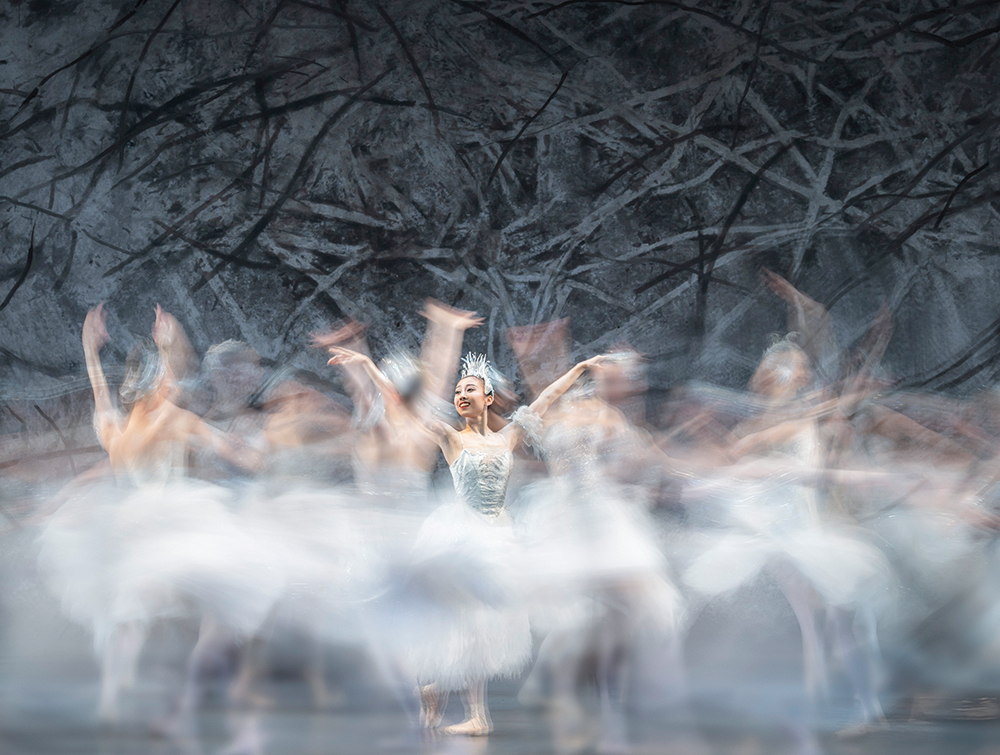Pantomime season is upon us, and unless your taste in colour runs no further than Smarties, there is no more magnificent spectacle on offer than Birmingham Royal Ballet’s production of The Nutcracker – performed so many hundred times since its première in 1990 that two years ago it disintegrated and required reconstruction.
Its scenery and costumes are the work of John Macfarlane, a softly spoken Glaswegian who is ranked worldwide as one of the great stage designers of his generation. They demonstrate in abundance a quality that characterises all his work: a brooding chiaroscuro, in which nightmarishly surreal flickers of ruin and decay are shot through with gorgeous sensuality. There is no tinsel-pink prettiness. His Nutcracker has been inspired by the haunted imagination of E.T.A. Hoffmann rather than the sugar coating of Walt Disney. Those of a nervous disposition might find it positively terrifying at moments. Everyone else is enchanted.
Throughout his career Macfarlane has gone his own way, standing apart from the fashionable theatrical trends for timber frames, chrome and leather, white boxes and video projection. ‘I’m not one to be bothered by what other people are doing,’ he says with a diffident shrug. If he stands in any tradition, it is that of the old-school illusionism of the proscenium arched theatre, with its hung backcloths, receding wings and magically ‘flown’ transformations. Mystery trumps clarity in his aesthetic and shadowy ambiguities mask the certainties of daylight.
Born in 1948, he comes from a creative background. His father was an architect and a fine watercolourist, his mother an embroiderer, and he spent much of his childhood making miniature toy theatres from matchboxes. After studying textiles at Glasgow School of Art, he won a Leverhulme Scholarship that led him to ateliers in Italy, Greece and Turkey. But he was always stagestruck, and finally found his métier in 1972 as an apprentice designer at the newly opened Young Vic. His first assignment there, put together ‘in three weeks flat’, was Rosencrantz and Guildenstern are Dead, and he went on to design plays by Pinter and Beckett. But the sort of minimalism this required never deeply engaged him, and he has seldom worked in the legitimate theatre since: he hankers for the freer rein and wider perspective that ballet allows him, and it is in that genre that he established his reputation, working across Europe with the choreographic likes of Glen Tetley and Jiri Kylian.
In 1984, he was given his first large-scale British assignment, when he arrived ‘frightened witless’ at Covent Garden to design Peter Wright’s Royal Ballet production of Giselle. Forty years on, its autumnal atmosphere and moonlit melancholy continue to delight, though for sheer show-stopping splendour it’s been capped by his sumptuous vision of Swan Lake, the final fruit of his long and extensive collaboration with the late Liam Scarlett.
‘Liam first asked for me when he was starting off as a choreographer,’ Macfarlane recalls. ‘He sent me tapes of his small-scale studio work and I was immediately blown away. There were 35 years between us, but he was the most wonderful person to work with. The speed and precision of his mind was astonishing, even if some things didn’t turn out completely successful. Sweet Violets [a riff on Walter Sickert and Jack the Ripper] was too complicated, but it had wonderful passages; Frankenstein didn’t go down well at Covent Garden, but it was a big hit in America.’
The one that got away could have been the crowning glory. After Swan Lake opened in 2019, the Royal Ballet’s director Kevin O’Hare asked Scarlett and Macfarlane to collaborate on a new production of The Sleeping Beauty, ‘and our answer was an immediate and emphatic yes’.

There is significant back history here. In 1946, Sadler’s Wells Ballet (which morphed into the Royal Ballet in 1956) laid claim to the Royal Opera House with a rococo staging of The Sleeping Beauty designed by Oliver Messel, the most celebrated designer of his day. In the context of post-war austerity, it looked astonishingly lavish and became the company’s defining statement, clocking up well over a thousand performances both in Britain and on tour of the USA. It continued in the repertory for 22 years before being replaced at budget-breaking expense by variously unsatisfactory stagings. In 2006, the management despairingly reverted to Messel’s 1946 designs – an exhumation about which Macfarlane is deeply sceptical.
‘The Royal Ballet has wasted so much money, resources and time on trying to recreate the Messel. It was a marvel in 1946 and still phenomenal when I saw it at the age of ten or 11. But expectations have changed so much meanwhile, it can’t be made to work now. For one thing, the palette of colours looks so odd – dirty pinks, sage green and creams. Everything about it has gone into sludge. There’s no magic, no darkness. It just looks dead. And I was prepared to give three years of my life over to making a completely new production with Liam.’ But tragedy intervened. In the wake of rumours of improper sexual advances, for which all investigations determined that ‘there were no matters to pursue’, Scarlett killed himself in 2021. ‘We were about to stage our Frankenstein for the Royal Danish Ballet when one of its dancers said that in the light of what they’d heard, they wouldn’t work with Liam,’ Macfarlane says. The company announced it was cancelling the production. Liam’s death was announced the next day. ‘I’ve done a suite of drawings of The Sleeping Beauty that give some idea of the approach we might have taken. Perhaps they’re my way of keeping Liam alive a little longer,’ Macfarlane adds.
Another larger-scale project has proved even more frustratingly evasive. As well as ballet, Macfarlane has been much in demand for opera, often working alongside the directors Richard Jones and fellow Glaswegian David McVicar in a wide variety of repertory. Three times he’s been offered the supreme challenge – ‘at which you’re meant to roll over with joy’ – of designing a Ring cycle; three times it’s fallen through.
‘Pappano wanted me for Covent Garden, but the schedule was impossibly tight,’ he says. ‘Later Chicago came up with a proposal, but they hadn’t got a director on board, so there was no way I could accept without knowing who I would be working with. Then we got all the ducks lined in a row for La Scala, with David McVicar directing, and that was exciting. I even made preparatory models and designs for the front cloths. But La Scala was just so maddeningly inefficient over any negotiations or arrangements that after six months of wrangling I had to walk away.’
Some sketches from the abandoned project featured in a new monograph and a small exhibition of Macfarlane’s work at Gainsborough’s House in Sudbury tantalisingly suggest what might have been: a richly romantic interpretation of Wagner’s epic, ghoulish and elemental, swirling with blood-stained, windswept and witchy images that seem to come from the dark heart of his native Scotland.
Now in his mid-seventies, based in a converted barn in rural Wales, itching to do more painting and gardening – and perhaps a little jaded after the disappointments of The Sleeping Beauty and the Ring – Macfarlane says he is reluctant to embark on any more theatrical projects. One just hopes his arm can be twisted.
Birmingham Royal Ballet’s The Nutcracker is at the Birmingham Hippodrome until 14 December and at the Royal Albert Hall from 29-31 December. John Macfarlane & the Art of Theatrical Design is at Gainsborough’s House, Sudbury, until 20 April 2025. John Macfarlane Theatre Design and Studio is published by Graffeg Books.







Comments